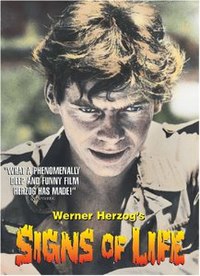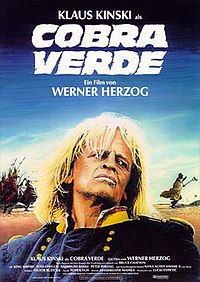 Ballad of the Little Soldier * * * *
Ballad of the Little Soldier * * * *Directed by: Werner Herzog / 1984
The Young Bare the Burden and the Arms…
“Ballad of the Little Soldier” finds Werner Herzog and Co. in Nicaragua following children soldiers. This is a documentary that I feel should be viewed in schools. I won't go into detail on this one. I would be interested in a follow-up by Herzog and his cameras some day.
 Precautions Against Fanatics * * *
Precautions Against Fanatics * * *Directed by: Werner Herzog / 1969
Way Before “Best in Show”…
Boasting a peculiar title, “Precautions Against Fanatics” might be Werner Herzog’s most peculiar movie, all 12 minutes of it. It feels like a blue print to the types of movie motives that Christopher Guest & Co. have lampooned time and time again, for some time now. It also seems the type of short film to inspire any of the millions of YouTube videos shot on the fly today with a pack of goofballs. Set at a horseracing facility, Herzog’s camera goes around interviewing eccentric horse trainers, track employees or racing enthusiasts. Every time, an absurd cranky old man intervenes yelling obnoxious remarks and telling them to get out. With everything said, “Precautions Against Fanatics”, from my knowledge of pop-culture, was years ahead of the comedy punches of the mockmentary, staged reality or practical blooper joke shows (uh, Ashton Kutcher-produced programming and MTV’s “Jack Ass”, among others) that we now take for granted and/or get too much of. But, I actually wanted more of it!
 Encounters at the End of the World * * * * *
Encounters at the End of the World * * * * *Directed by: Werner Herzog / 2007
Let's take a field trip to McMurdo Station…American Scientific Settlement…Antarctica…Earth.
As God’s children we should behave accordingly instead of exhausting our Mother Earth’s resources, like a mother whose fuse is shortened by a child’s heightened sense of not having any sense. But, what is “behave accordingly”? The word “behave” has two words in it, “be” and “have”. I sometimes just yearn to “be” and with peace of mind, like a child, but at the same time I have to play adult and sometimes that means I “have” to “have” my share and piece of mind, instead of peace of mind. As humans it’s in our driving initiative to put everything under the microscope, to poke and to prod, to exploit, to show-off, to gain founders rights and an objective of intellectual gain. Rarely do we sit back and soak in the given. And will we truly be forgiven? Time will tell, at least in our relation to Earth’s perspective.
Werner Herzog approaches his film subjects like a carver of curiosities, Antarctica being one of his latest escapades, more appropriately ice capades, and it’s a wonder why it has taken Herzog this long to wander his wonders to the belly button of the world's belly. Well, because it's pregnant with life. It’s a thinker’s tank down there and on a surface of "moon-like" conditions as described by some of the inhabitants of America’s McMurdo Station, a scientific settlement nearly four times the size, and more Americanized, than even that of my actual Americanized home town. It wasn’t what I was expecting and neither was Herzog, as he wanted to get out of town and into iceberg exploration the minute he stepped off the plane. I don’t blame him. But, he stumbles on a story behind every door and behind every travel-worn face of these people. There is a line from the ‘90s comedy, “Tommy Boy”, that has always stuck with me and that is, “Your Dad could sell a ketchup popsicle to a woman in white gloves!”, and I think that if there was such a salesman, Herzog would be on the other end of the camera with white gloves on. He just has a knack for finding something in everything and everyone.
The residents of McMurdo all share a similar interest in what seems to be out of the box experiences, even when they’re in the box, so to speak, cut off from the rest of the world. Not to mention when they’re practicing survivor classes with bucket blinders over their heads to simulate a whiteout (one of my favorite scenes). The end of the world has pulled them in like a magnet. The end is their beginning, the bottom is their top. OK, you get it. Some have come to escape a dark past. Others have come due to their constant search of eccentric adventure or wonderment. Many are there for their love of the work (and ice cream, guitar concerts and science fiction films) and to simply be in remote isolation. There are even some who have bags packed at all times, ready to move on if need be, even if they are surrounded by ice and water. But, all have truly lived more than I have and I’m oddly engaged to their inspiring tales and trials through travel. In fact, I found the filmed portions of the people of McMurdo just as captivating as its strange frozen surroundings, ice bergs, actively spitting volcanoes, underwater creatures that give off Pink Floyd-like recordings, two-story naturally made ice sculptures that house toxic gases and water cathedrals with alien-like creatures under the Herzog coined “frozen sky” of the iced-over sea. Though, there is an odd juxtaposition of McMurdo’s curious, childlike-play people and their drive to want to scientifically figure out Mother Earth. But, in the end these are still God’s children and even still, serve as a unique parallel to a lone, adamantly wandering penguin taking his own path to certain doom instead of following the other penguins. It’s a path we’d all want to aid motherly care package advice to, but he’s free to make that choice to poke and prod on his own path of choice and his own journey and calling.
As a documentarian you can say that Herzog too pokes and prods. Though, it rarely comes with the gusto for scientific documentation of film studies advance (well, maybe a bit of that and just some intellectual studying), rather that simple yearning of child awe, spirit and artistry. Herzog has a wonder about him, at times eccentric, but always with a keen eye and brain even to squeeze something extra out of the ordinary and is careful not to draw a fine line between “normal” and “insane”. His camera is constantly looking for something mind-boggling, impressive, inspiring, worshipping, poignant and at times humorous. He even finds these things in the things that seem the complete polar opposite. When someone speaks of their love for Antarctica and its “similar to the moon” likability, the camera tells what could be the rest of the story. As it captures the earth worked over by human dirt machines and “progress” taking place, one can’t help but visualize how the moon will look once we conquer and colonize it and beyond, leaving our inevitable travel tattoos (most likely after we come close to fully exhausting our Mother). And at the same time you can’t help but want to be a part of that in some strange way.
Just like the mysterious come and go of the dinosaurs, humans will too. We’re up to the plate and all signs appear that we’re down in the count. The doctor playing on Earth has good, bad and ugly to its game and maybe just maybe it can boost us to having better odds if we pay attention? Though, perhaps when future civilizations, maybe aliens, come to see who we were and what we were about, they’ll happen to find a complete box set of Werner Herzog curiosities and documentations on Earth (of course they’d have to have a device to make them work, but please humor for a little longer) sitting in a shrine right next to the detailed cast of a sturgeon also mysteriously found frozen in time at the end of the world.
While Mother Earth is busy speaking, are our busy bodies truly listening instead of putting stethoscopes, microscopes and tattoos to the tune of discovering, documenting, detailing…detaching and weaning off from the mystery and childlike wonderment? But, children are nothing more than little adults, naively wandering into a foreign playground to be the first to slide down the slide with a bucket over their heads. And you can bet your bucket that Werner Herzog will be at the bottom with a camera and curiosity.
 Fata Morgana * * * *
Fata Morgana * * * *Directed by: Werner Herzog / 1971
Drive-by Sci-Fi…
Like “Burden of Dreams” is to Werner Herzog’s “Fitzcarraldo”, the making of “Fata Morgana” could have made for a great movie by itself. It seems like the stuff of myth or legend: shooting for 13 months without any story idea or structure (though, nothing too unusual for this director); surrendering to border police; the contraction of a rare liver disease that nearly caused Herzog’s death; tortured mentally and physically in prison. Watching the deserted desert images of “Fata Morgana” fly by to narration of ancient poetry and the appropriately applied tunes of Leonard Cohen, classic compositions and instrumentals, was a visual feast that kept getting better and better and more unusual in the hour and eighteen minutes it clocks in. At times the people, wrecked landscape, living conditions and creatures reminded me of production art plucked out of movies like “Mad Max”, “Dune” or “Star Wars.” As it turns out, Herzog’s stick-to vision of the film (one that is explained in the DVD extras) is that it IS intended to be viewed as sci-fi, as in an alien film crew has come to Earth after humans have nearly exhausted it. I went into “Fata Morgana” without any research or knowledge other than friends referring it to me as “it’s about mirages and desert life…a little slow…kind of boring…nonsensical…but, unique and fascinating.” Actually, this film did start slow and at times I wasn’t sure how to piece it all together, and not even sure if I should try, but “Fata Morgana” turned out to be nothing short of what I’ve come to call a uniquely tailored Herzogian experience. And it’s certainly not just about mirages in the desert. It’s another in a long line of the man’s astounding abilities to translate life to the screen that I’d like to put on repeat. Like me watching Herzog over and over, HE too fixates on the repetition of the images he finds in movies like “Fata Morgana”. Whether its sea turtles in the desert (yeah?!), an elderly couple playing weird musical compositions in confidence, a cutely-odd-looking albino desert fox or an abandoned truck doing donuts in a distant mirage (looking nothing short of an alien crab creature scuttling around)…this film is nothing short of fascinating and set the stamp for all Herzogian experiences to follow.
 Werner Herzog Eats His Shoe * * * * *
Werner Herzog Eats His Shoe * * * * *Directed by: Les Blanks / 1980
I Smell a Sequel…
Academy Award winning filmmaker Errol Morris released his debut, “Gates of Heaven”, in 1980. Upon doing so, he had fulfilled a bet with friend and fellow filmmaker Werner Herzog. This bet, proposed by Herzog, promised he would eat his shoe if Morris ever completed a film. Herzog is a man of his word, right down to the exact shoe(s) he was wearing when he made the bet. However, he didn’t envision the moment would be made famous (or infamous) in front of a packed auditorium, not to mention the plot of a short film captured by documentarian Les Blanks (who would later document Herzog’s plagued filmmaking vision of “Fitzcarraldo” in “Burden of Dreams”). Boiled for 5 hours in a wash of Herzog’s own recipe of flavored water, the entire shoe was consumed by Herzog. Well, everything but the sole, as in great Herzogian vision it was explained that you don’t eat chicken bones. Makes sense to me. But, what about the other shoe!
 Burden of Dreams * * * * ½
Burden of Dreams * * * * ½Directed by: Les Blanks / 1981
River Rapids, River Wild…
There aren’t too many films in the over 100 year history of the medium where the director’s vision nearly exhausts the film and the final product. However, the 1970s was a big turning point in movie making. Not only so in the art and exploration of film, but also for eccentric rights to film production and directors as a whole exercising their angels and demons. Names like Francis Ford Coppola and Michael Cimino always come to mind with stories surrounding their wonderful visions that nearly collapsed themselves and others with “Apocalypse Now” and “Heaven’s Gate”, respectively. These are films that carry as much talk about the behind the scenes as the actual product. The stories and products are equaled masterpieces in my book. Though, I think that Werner Herzog takes the prize, as he was in complete artistic control-out-of-control, with the grandest of grand visions in “Fitzcarraldo.” From conception to end, enduring great set-backs in cast, production and location he succeeded in leading to near ruin. Most notabl: scrapping 40% of a movie after lead actor Jason Robarbs’ near life-threatening illness forced him to bail, thus resulting in Mick Jagger (Yes, THE Mick Jagger!) leaving for tour as he couldn’t wait any longer; replacement actor Klaus Kinski’s raging tantrums which resulted in murderous plots on his life; the drowning of two native Indians; the Peruvian jungle in general; and last but not least, Herzog’s vision for an actual 320-ton steamship hauled over a mountain by man power. Les Blanks’ “Burden of Dreams” captures true history and true movie making in the making. Though, I still think the best scenes are ones withheld of Kinski’s most outrageous expressions, ones that can be seen in Herzog’s 1999 documentary on his relationship with Kinski called “My Best Fiend.” In the end, Herzog is still testing not only the film medium but also his visions and getting a much heralded late-career boost and still complete control, something that guys like Coppola and Cimino have either stepped back from or are completely in hibernation.
 Signs of Life * * *
Signs of Life * * *Directed by: Werner Herzog / 1968
Windmills of the Mind…
I didn’t realize it until I read Netflix’s synopsis on the “Signs of Life” mailer, but Werner Herzog’s film and screenplay inspired Stephen King’s idea behind “The Shining.” Cool. I can see why with its closed-wall-isolation-turn-madness, though I prefer Stanley Kubrick’s movie “The Shining” to “Signs of Life.” Herzog’s first feature film isn’t a bad film at all. It does move slow and feels drawn-out for a film that isn’t really that long. Which, isn’t a bad thing. Though, at times it shows a hard time of knowing what to do as a film. At least these things were present to me and in a Herzogian way I’ve come to admire that. Especially so, because it shows how Herzog cut his teeth and mind with putting images together, images like a field of thousands of windmills that the seemingly normal lead character stumbles upon and becomes almost disillusioned and disturbed by. It’s a crucial point and great metaphor for the power on display, and/or the switch of power, that takes place as he begins to go mad after many days of isolation with a few others stationed at a military base. Werner Herzog is a true original and in a lot of ways I find his first feature film to show many signs of a creative life waiting to kick the door wide open on the medium. I recommend “Signs of Life” to see a master filmmaker making his baby kicks and starting to canvas the windmills of his own mind.
-djg






